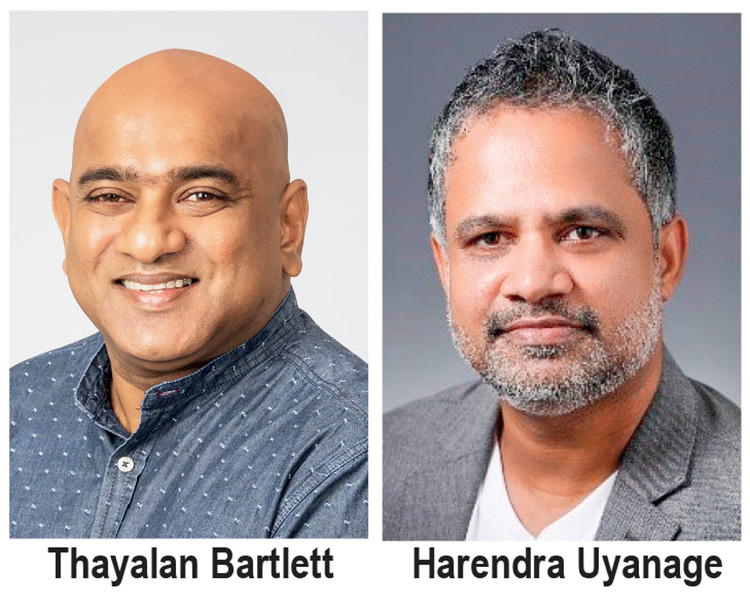Business
Real question is not whether SL should go to IMF or not: Verité Research

‘ Sri Lanka makes the mistake of letting IMF write a plan for the country’
by Sanath Nanayakkare
The real question is not whether Sri Lanka should go to the IMF or not. What is important is going to the IMF with confidence after having analysed the fiscal situation, with a convincing plan, Executive Director of Verité Research Dr. Nishan de Mel said in Colombo recently.
He made this remark at a CEOs Forum hosted by CA Sri Lanka to provide clarity on the current debt situation, whilst also helping the business community gain a better understanding on the government’s strategy and way forward to navigate through the ongoing situation.
State Minister of Money and Capital Market and State Enterprise Reforms Ajith Nivard Cabraal, was the guest speaker and the panel session brought together eminent speakers comprising of Governor of the Central Bank of Sri Lanka Professor W. D. Lakshman, Chairman of the Ceylon Chamber of Commerce Vish Govindasamy, [Executive Director of Verité Research (Pvt) Ltd Dr. Nishan de Mel], and Managing Director of Fitch Rating Agency Maninda Wickramasinghe.
Dr. Nishan de Mel further said: “For instance, when you go to a bank with a business idea to take out a loan, the bank says, ‘give me your plan’. But if you get the credit officer to write the plan for you it won’t be appropriate. The mistake Sri Lanka makes is letting the IMF write that plan for the country because the country doesn’t have one. The crux of the matter is; the credit officer shouldn’t write the plan. The country should present the plan and convince the credit officer that the plan has the potential to work out – a plan backed by an analysis that can win the confidence of the lender. That’s the structured way to obtain an IMF facility for Sri Lanka. I do hope that we can take that path.”
“The Central Bank may have a different approach to analyzsng the situation – I think publishing that analysis would be very valid because that is a test of some scrutiny and others would be able to look at it – that is a way to give confidence. I completely accept that there is no one way to analyse the situation and determine the approaches we can take, but it is important to make the chosen approach public.”
“The government and the Central Bank of Sri Lanka (CBSL) are on the right path with regard to reducing the ratio of foreign debt to domestic debt, but the greater reliance placed on domestic financing too quickly would be like running a marathon too fast as it could burn out the accelerated shift.”
“On the other hand, we might not have the option of being too slow on this aspect as rating agencies are downgrading and the markets are observing. Amid this we have to build confidence. These are very concerning which is why I say it is not too late for Sri Lanka to realign its strategy to get out of the problem and to keep its debt sustainable while making sure we won’t run into a liquidity crisis.”
“Verité’s own analysis shows that there are four steps that can make debt repayment more sustainable and a fifth step to avoid a reserve crisis which people are worried about.”
“Number 1; the interest rates on local debt can be no higher than inflation which I think we have probably achieved. The Central Bank has had a larger tolerance for inflation and it will end up in 6.5% range, and interest rates on local debt have been brought down which is an important part of the function. I t will take some time for all the government debt to reflect that lower rate, but that in reality is the right path. However, it’s a cost to society because inflation is costly in terms of real returns from your bank balances or investments.”
“Secondly, interest rates on foreign denominated loans can’t be higher than GDP growth There also Sri Lanka is well placed because even though we talk about having a large amount of commercial debt, the history of concessional debt is so high that our weighted average interest rate on foreign denominated debt is still only 3.9%, and going forward with a growth of about 4%, we can maintain that. Being able to maintain the interest on that percentage rate for foreign denominated loans is favourable for Sri Lanka.”
“Then there are two other conditions that Sri Lanka needs to do more about. One is the primary deficit- that is the deficit after paying interest- which should be less than 60% of GDP growth – that means if the GDP growth is 5%, primary deficit can’t be more than 3%. If we are expecting a lower GDP growth this time; say a growth of 3.3%, then the primary deficit can’t be more than 3%. So we really have to control that and bring it down. And it is very important to report those numbers correctly to give the markets that confidence. This still allows for a budget deficit in the high single digits because our total interest on debt is over 6% of GDP. This is not drastic, but it says that deficit has to be in the mid single digits. If we want to maintain the deficit, we need to be able to manage the upper single digits with a doable plan.”
The fourth is that depreciation of the currency can be no higher than inflation, and that brings us to the fifth step because currency depreciation today is not based on the fundamental mismatch in global crisis vs Sri Lankan crisis. From 2015 to 2019, one of the major important adjustments made was, to bring it to what you call the real exchange rate. Sri Lanka’s exchange rate until 2015 was significantly over valued. Even though depreciation hurt, the adjustment brought stability. That was an important alignment. That alignment is still sort of in place but today because of the uncertainty about the reserves, you see a speculative exchange rate- and that simply puts pressure on depreciation.”, he said.
Business
HNB Assurance Recognized with Merit Award at the Great HR Awards 2025

HNB Assurance PLC was recognized at the Great HR Awards 2025, receiving the Merit Award in the Finance, Insurance, Real Estate, and Investment sector. This recognition reflects the company’s continued commitment to strengthening its people strategy, nurturing a progressive culture, leveraging technology and maintaining strong industrial relations.
Sharing his thoughts on this accomplishment, Lasitha Wimalarathne, Executive Director / Chief Executive Officer of HNB Assurance PLC, stated, “This recognition reiterates our belief that people are the true drivers of our success. Over the years, we have invested significantly in building an environment where our teams feel inspired and supported to deliver their best. As we continue to grow as one of Sri Lanka’s best insurance companies, this award reflects our ongoing efforts to build a workplace where both our people and our business can thrive. My sincere thanks go out to our HR team for continuously driving these initiatives.”
Commenting on the award, Navin Rupasinghe, Head of HR / DGM at HNB Assurance PLC, said, “Our people-first philosophy shapes every HR initiative we design, from strengthening learning pathways and leadership development to enhancing employee well-being and engagement. This recognition validates our ongoing efforts to build a workplace culture grounded in trust, inclusivity and performance. As we look ahead, we remain committed to evolving our HR practices to meet the expectations of our people and the future of work. My sincere thanks to the CIPM for this recignition.”
Business
MullenLowe Sri Lanka named Creative Agency of the Year in South Asia

MullenLowe Sri Lanka has been awarded Gold as the Rest of South Asia’s Creative Agency of the Year at the Campaign Agency of the Year Awards 2025, held recently at Mumbai’s ITC Maratha Hotel. The accolade marks a landmark year for the agency, driven by breakthrough ideas, ambitious brands, and a surge in economic activity.

Campaign Agency of the Year – South Asia 2025 (Rest of South Asia – Creative Agency) awarded to MullenLowe Sri Lanka
Guided by a clear creative vision and extensive category expertise across 111 brands in 33 sectors, MullenLowe strengthened its position through strategic leadership appointments, talent acquisition, and the integration of AI-enabled tools. These initiatives created an environment where creativity, learning, and commercial impact worked in tandem, supporting long-standing client relationships and consistent new business momentum.
Thayalan Bartlett, Executive Chairman, said, “Our growth is rooted in a people-first, creative-centred culture. By attracting top talent and focusing on continuous upskilling, we have enriched both our creative and strategic capabilities.”
The agency’s innovation was further enhanced by Fever, its AI-enabled production studio, and LoweGo, a subscription-based design unit, enabling faster and more scalable solutions for modern marketers. Training programs, including an international AI workshop in Baku for top creative minds, helped unify teams around technology-driven creativity, leading to MullenLowe’s highest Effie points haul in a decade.
Harendra Uyanage, Senior Vice President and Executive Creative Director, added, “This recognition celebrates a team that constantly stretches its creative boundaries, transforming every brief into opportunity.”
The win adds to a series of recent accolades, including Most Effective Agency of the Year at the 2024 Effie Awards, and multiple awards at Dragons of Sri Lanka and SLIM Digis 2025, cementing MullenLowe’s vision to become Sri Lanka’s most commercially impactful creative company by 2030.
Business
ComBank named Sri Lanka’s Best Trade Finance Bank at Euromoney Awards 2025

The Commercial Bank of Ceylon PLC was named Sri Lanka’s Best Trade Finance Bank at the prestigious Euromoney Transaction Banking Awards 2025, in recognition of the Bank’s strong performance and continued contribution to supporting Sri Lanka’s export and import sectors.
This global recognition from Euromoney, a leading authority in financial markets, celebrates institutions that demonstrate innovation, leadership, and measurable impact in transaction banking across cash management, payments, trade finance, and technology. Commercial Bank is Sri Lanka’s clear market leader in trade finance, commanding a 21% share in exports and a 14.26% share in imports, demonstrating its strong presence across both segments.
In 2024, the Bank supported over US$ 5 billion in trade transactions, underscoring its unmatched role in enabling the flow of goods, services, and foreign exchange. Its leadership has also been recognised regionally by the Asian Development Bank (ADB), which named Commercial Bank its Leading Partner Bank in Sri Lanka for the fourth consecutive year under the Trade and Supply Chain Finance Programme.
At the forefront of Commercial Bank’s recent innovations is ComBank TradeLink, Sri Lanka’s first fully integrated, end-to-end digital trade finance platform. The system brings all trade finance operations – from Letters of Credit to export collections and shipping guarantees – into one secure online interface, providing customers real-time visibility, faster processing, and paperless convenience. This digitalisation drive has redefined the client experience, reduced manual processes and improved turnaround times across thousands of transactions.
The Bank’s commitment to advancing Sri Lanka’s trade sector extends beyond technology. Through initiatives such as the ComBank Trade Club, which facilitates connections between buyers and suppliers both locally and internationally, and ComBank LEAP | GlobalLinker, a digital business networking platform for SMEs, the Bank is actively building bridges between Sri Lankan entrepreneurs and global markets. Its Diribala Exporter Development Programme further empowers micro, small, and medium enterprises to become export-ready, providing access to expert guidance, training, and financial support.
Reflecting on the award, Commercial Bank said the recognition from Euromoney was a tribute to the trust placed in the Bank by Sri Lanka’s exporters and importers, and to the dedication of its trade finance teams who continue to innovate and deliver excellence in a rapidly evolving global landscape.
As Sri Lanka’s largest private sector bank and the first to surpass US$ 1 billion in market capitalisation, Commercial Bank continues to lead in supporting national trade, driving digital transformation, and shaping a more inclusive and resilient export economy, the Bank said.
Commercial Bank was the first bank in the country to be listed among the Top 1000 Banks of the World, and has the highest Tier I capital base among all Sri Lankan banks. The Bank is the largest private sector lender in Sri Lanka and the largest lender to the country’s SME sector. Commercial Bank is also a leader in digital innovation and is Sri Lanka’s first 100% carbon-neutral bank.
Commercial Bank operates a network of strategically located branches and automated machines island-wide, and has the widest international footprint among Sri Lankan banks, with 20 branches in Bangladesh, a fully-fledged Tier I Bank with a majority stake in the Maldives, a microfinance company in Myanmar, and a representative office in the Dubai International Financial Centre (DIFC). The Bank’s fully owned subsidiaries, CBC Finance Ltd. and Commercial Insurance Brokers (Pvt) Limited, also deliver a range of financial services via their own branch networks.
-

 Features4 days ago
Features4 days agoFinally, Mahinda Yapa sets the record straight
-

 News6 days ago
News6 days agoOver 35,000 drug offenders nabbed in 36 days
-

 News5 days ago
News5 days agoCyclone Ditwah leaves Sri Lanka’s biodiversity in ruins: Top scientist warns of unseen ecological disaster
-

 News6 days ago
News6 days agoRising water level in Malwathu Oya triggers alert in Thanthirimale
-

 Features4 days ago
Features4 days agoHandunnetti and Colonial Shackles of English in Sri Lanka
-

 Business3 days ago
Business3 days agoCabinet approves establishment of two 50 MW wind power stations in Mullikulum, Mannar region
-

 Business6 days ago
Business6 days agoSri Lanka betting its tourism future on cold, hard numbers
-

 News6 days ago
News6 days agoNew landslide alerts as Ditwah aftermath worsens













